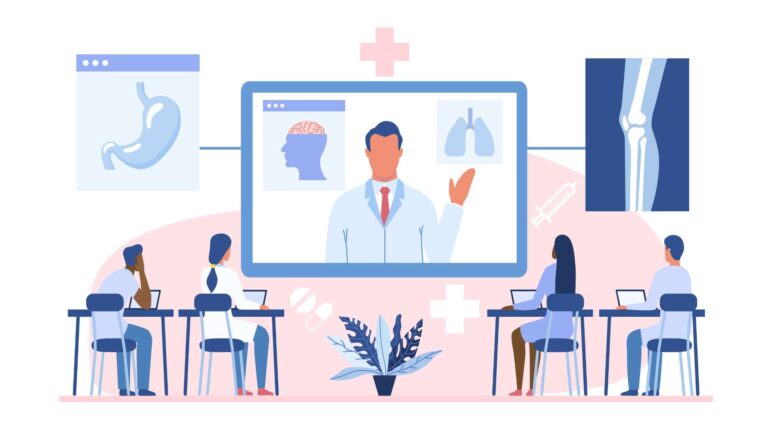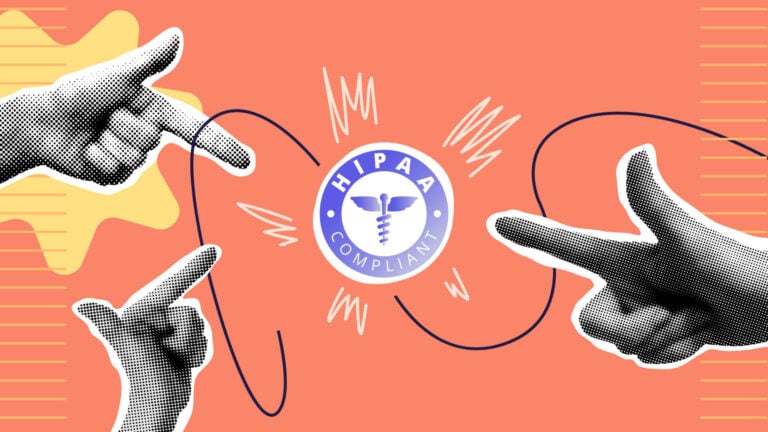Choosing a healthcare learning management system (LMS) can be overwhelming. There’s no shortage of software options, but they must meet your healthcare organization’s needs by offering customizable courses, cost-effectiveness, and more.
Don’t worry—I’ve done most of the legwork for you.
In this article, I review the best LMS for healthcare so you can find the right match for your team.
Our Top Picks
-
Best all-in-one healthcare learning management system
-

Good for: AI-powered course creation
-
Good for: Live training sessions
Why trust us?
Our team of unbiased software reviewers follows strict editorial guidelines, and our methodology is clear and open to everyone.
See our complete methodology
17
Tools considered
10
Tools reviewed
5
Best tools chosen
How I Chose the Best Healthcare Learning Management Systems
Here’s how I selected my top 5 healthcare employee training apps.
First, I looked for these must-have features:
- Ready-made courses: Instantly distribute healthcare-relevant courses to your staff.
- User-friendly course builder: Create new courses intuitively using existing materials or new content.
- Third-party course imports: Easily add existing courses from other LMS platforms.
- Multimedia course content: Add a mix of content types—including text, photos, and videos.
- Quizzes: Test employees’ skills and knowledge as they progress through courses.
- Gamification: Engage learners with game-like features, such as point scoring, leaderboards, and collaborative whiteboards.
- Progress tracking: Check teams’ and individuals’ training progress and review quiz scores.
I also made sure the software is:
- HIPAA-compliant, so protected health information (PHI) is secure.
- SCORM-compliant, letting you import courses easily from other SCORM-compliant LMS platforms.
- Mobile-optimized, enabling staff members to learn on the go.
- Accessible 24/7, so healthcare workers can learn at any time, including during night shifts.
- Cost-effective, offering excellent value.
Finally, I checked for features that make healthcare LMS apps great:
- Surveys: Send surveys to get employee feedback on existing and future training.
- In-app chat: Offer 1-on-1 feedback and enable company-wide discussions.
- Onboarding: Auto-assign training to new starters.
- App notifications: Automate reminders to nudge workers to start and finish courses.
- Automated certificates: Generate course completion certificates automatically to save time.
- Credentialing: Track employee credentialing and automate renewal notifications.
- Knowledge base: Summarize and organize essential knowledge that employees can access at any time.
- Admin reports: Export detailed training data to monitor employee competencies and stay compliant.
The 5 Best Healthcare Learning Management Systems of 2025
-
Connecteam — Best all-in-one healthcare learning management system
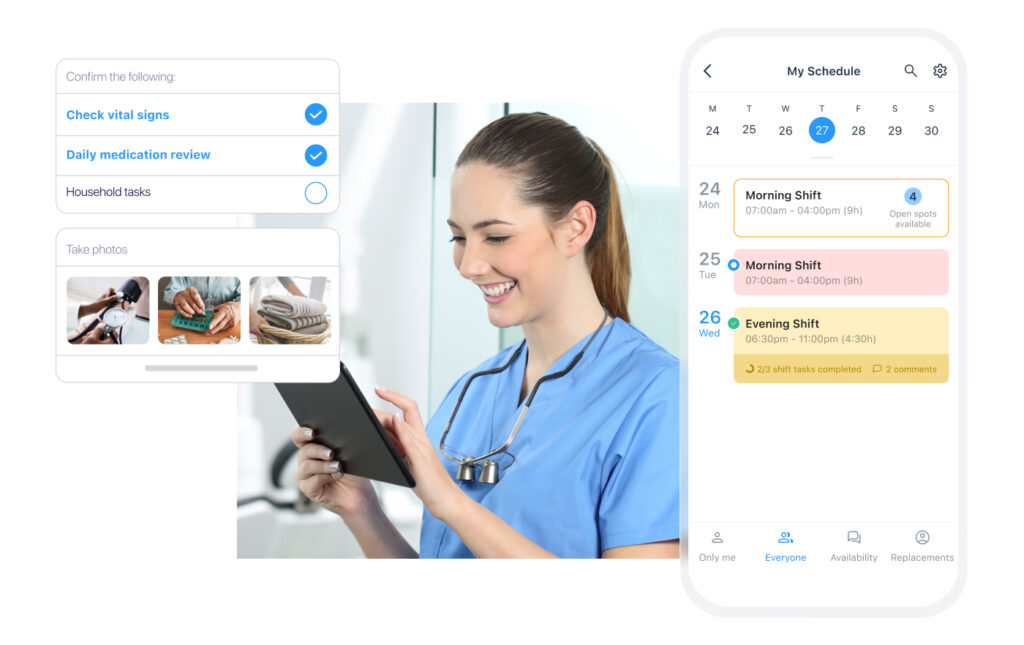
Connecteam is a HIPAA-compliant LMS that helps healthcare organizations easily scale and track training.
Why I chose Connecteam: Connecteam is my favorite all-in-one healthcare learning management platform. It lets you standardize training across teams and locations so you stay compliant and deliver excellent care. Plus, it’s user-friendly, boasting an average employee adoption rate of 92%.
Here’s a closer look at Connecteam’s LMS for healthcare.
Create training courses in just a few steps
The employee training app lets you provide unlimited training courses with customizable sections, bite-sized lessons (micro training), and quizzes. Employees learn at their own pace from any device—which is great for deskless healthcare workers.
Conveniently, Connecteam offers pre-made courses you can distribute to your staff with 1 click. Plus, you can build unlimited courses simply by uploading materials like PDFs, links, and videos. I especially like that Connecteam is SCORM-compliant.
You can add courses to employees’ dashboards in just a few taps by specifying departments or job types—or manually assigning them to specific users. You can also automate course assignments, such as induction training during the onboarding process. Once assigned a course, workers get completion reminders on their devices.
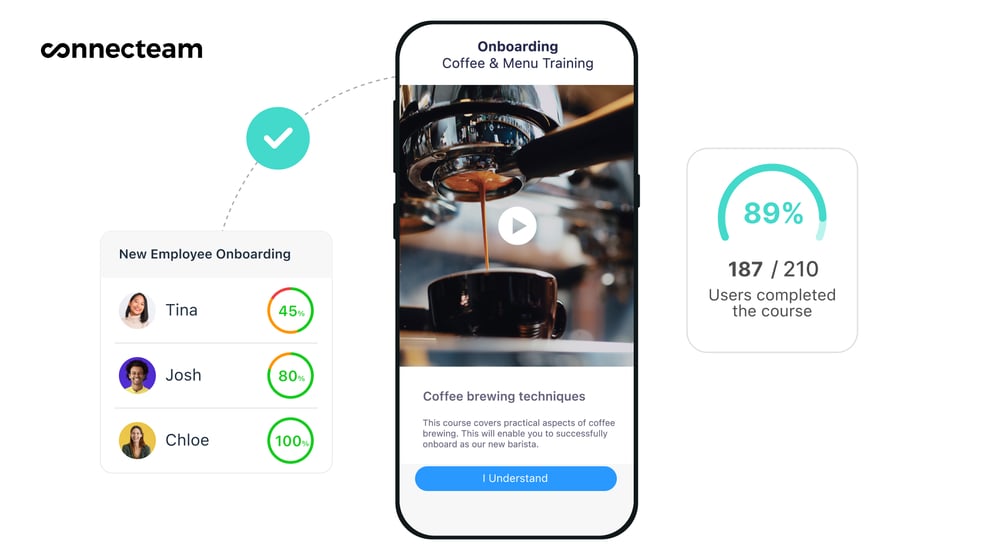
Engage learners with multi-format, gamified content
I find Connecteam courses really engaging for learners. Gamified features incentivize progress and include point scoring for quizzes and badges for completed training. Various content formats—including video, text, and quizzes—make courses more fun.
Track and ensure compliance
Connecteam functions as a compliance tracker, telling you which employees must complete mandatory training. It also enables compliance training on top of state-specific skills and specialist healthcare training.
A detailed record of all employees’ courses and test results ensures you’re ready for potential inspections. Plus, you can store unlimited staff documents on Connecteam, including certificates and credentials, and get automated renewal reminders.
Track employee progress with real-time updates and employee timelines
Your admin dashboard offers a real-time overview of employees’ course progress, including percent-based completion rates and average quiz scores. More in-depth course-level metrics tell you which lessons individual employees completed and the answers they gave to quiz questions.

In addition, Connecteam’s employee timeline management feature gives you an overview of each individual employee’s completed training, certifications, performance evaluations, and more. This overview enables better training decisions, and you can even add training courses and refreshers directly to timelines.
Provide feedback and answer questions with a team chat
Connecteam’s team instant messaging lets you give learners direct feedback and answer training-related questions. I love the chat’s features—for instance, you can create unlimited group chats, send voice notes, and add attachments. The app is HIPAA-compliant, so any information you exchange is secure, including PHI.
Organize information with a knowledge base
Use the knowledge base to complement training. For instance, it can store standard operating procedures (SOPs) related to course topics, like the use of specific lab equipment. Employees can easily browse the knowledge base or access knowledge base articles directly through course lessons.
Get employee input using surveys and forms
Connecteam’s employee communication surveys let you collect staff input, including new training ideas and feedback. For instance, you could automate a post-training feedback survey with questions such as “Rate your overall learning experience (1-5).”
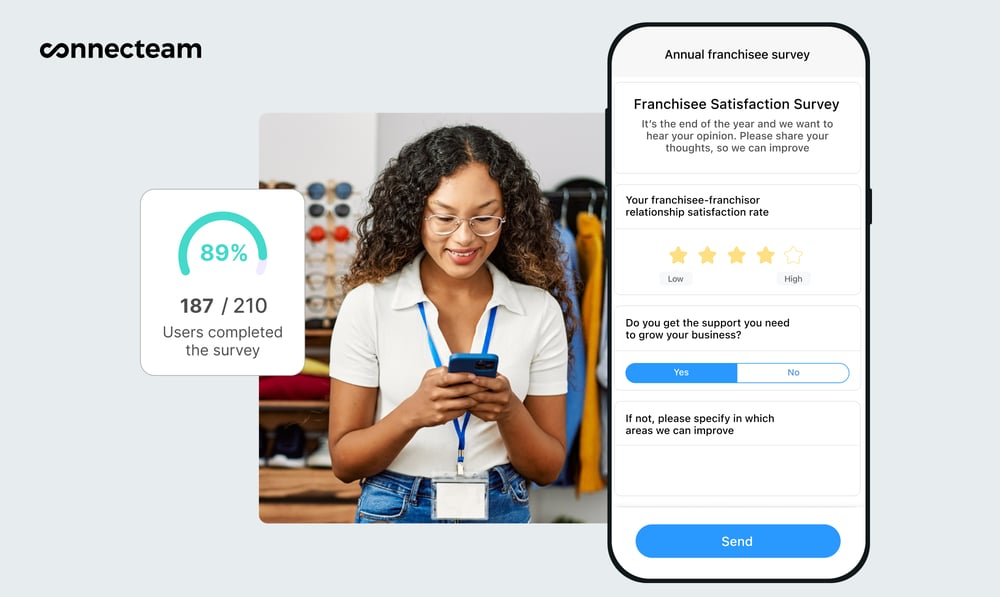
Likewise, you can use information from digital forms—such as hazard reports or patient feedback forms—to identify employee upskilling areas. For example, negative patient feedback might prompt a new employee communication course.
Send team-wide announcements—and much more!
You can broadcast company-wide announcements on the social feed, including info on new training courses.
Plus, Connecteam offers a full suite of healthcare workforce management features. With one app, you can:
- Manage team events, including live training sessions
- Collect employee e-signatures
- Localize global teams’ experience in +18 languages
- Create team schedules
- Create, assign, and track tasks
- Streamline payroll with a 1-click employee time clock
- Approve time off, overtime, and timesheets
- Create procedural checklists
- Generate reports to analyze time and labor costs
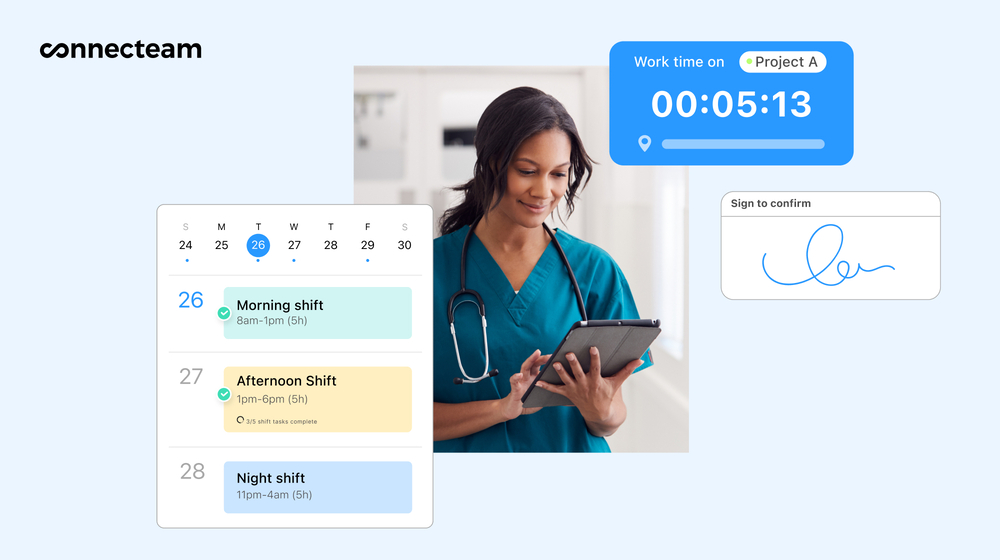
Crucially, Connecteam’s features work in sync. For instance, I find it useful that the software can block workers from certain shifts until they’ve completed specific training.
Connecteam is also easy to set up and use, accessible via a mobile app and a web version. It’s affordable, too, with a free-forever Small Business Plan and paid plans starting from just $29 per month for up to 30 users.
Note: These prices do not reflect the additional fee of adding HIPAA compliance to an account.
Connecteam also offers a free for life plan – Try Connecteam here!
Key Features
Course builder
Multi-format micro training content
Knowledge base
Team-wide announcements
Quizzes, surveys, and forms
HIPAA-compliant team chat
Pros
All-in-one LMS
Option to import content from files and SCORM-compliant platforms
Compliance and certificate tracking
Affordable per-user cost
Cons
More features in development
Pricing
Free-for-life plan availablePremium plans start at $29/month for 30 users
14-day free trial, no credit card required
Start your free trial -

Absorb LMS — Good for: AI-powered course creation
Available on
- Web
- iOS
- Android
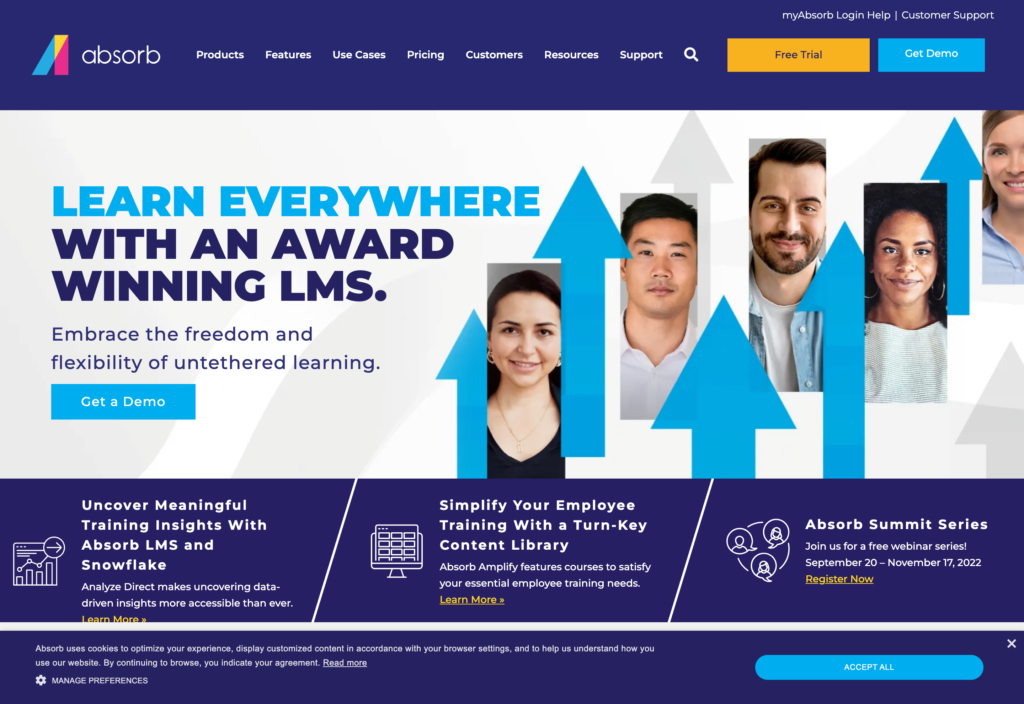
Absorb LMS is a modern healthcare LMS that lets you create courses quickly and prioritizes learner engagement.
Why I chose Absorb LMS: Absorb LMS offers an intuitive course builder, a customizable learner dashboard, gamified features, and useful tools like employee polls. It uses artificial intelligence (AI) to automate manual tasks—like video transcribing.
That said, it lacks an advanced employee directory and HIPAA-compliant team chat, which I find to be a major drawback.
Here are Absorb LMS’s top features.
AI-assisted course builder
Absorb LMS’s AI and natural language processing (NLP) tools automatically transcribe and time-stamp recorded videos. Learners can quickly scan published video transcriptions by searching for keywords.
AI also helps you perform everyday tasks—like running course completion reports—using simple conversational chatbot-like prompts.
Gamified and collaborative training
I appreciate Absorb LMS’s learner engagement features. Healthcare employees win points as they learn, and leaderboards rank top performers. They can also exchange comments on discussion boards, rate courses, and share accomplishments on team news feeds.
Additionally, you can create and send employee polls and easily publish poll results on the company feed.
Customizable learner dashboards
You can customize users’ billboards (dashboard banners) to promote new or urgent training. Staff members also see their in-progress courses, recent company announcements, and the wider course catalog on their dashboards. I really like that you can embed company posts from third-party social media platforms into training feeds.
Observation checklists
You can create observation checklists in Absorb LMS. For example, one checklist might contain the tasks that nursing home nurses must do effectively. Next, a reviewer can observe employees’ tasks (in-person or remotely) and add “pass” or “fail” marks to checklist items.
You can use these observation checklists to inform role-specific training and support regulatory compliance.
Integrations
Absorb LMS integrates with multiple content libraries, including LinkedIn Learning, Skillsoft, and MedTrainer. Learners can access these third-party courses directly on Absorb.
On top of that, the platform integrates with software including Zoom, Salesforce, and BambooHR. This lets you use training data on other HR software and vice-versa.
What users say about Absorb LMS
The best thing about absorb is honestly the support team. The product itself is good, but it’s really made amazing by the crew that I can constantly contact to get things solved.
No direct connector with our HRIS system, Workday.
Key Features
- AI training creation
- Social, gamified learning
- Third-party course integration
- Observation checklists
Pros
- AI speeds up video transcribing
- Platform offers 24/7 learner access
Cons
- No employee directory or team chat
- No forever-free plan
Pricing
Starts at $800/month Trial: Yes Free Plan: No
-
TalentLMS — Good for: Live training sessions
Available on
- Web
- iOS
- Android
- Windows
- Mac
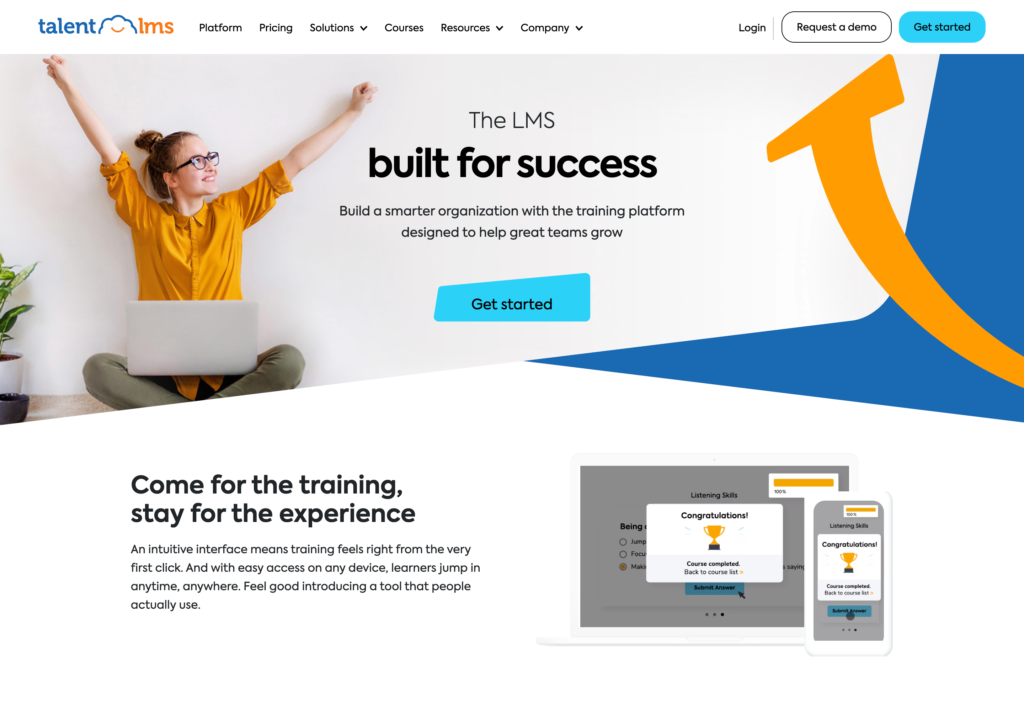
TalentLMS is a comprehensive training and development solution for healthcare that hosts both live and on-demand courses.
Why I chose TalentLMS: TalentLMS features pre-made courses, an AI content generator, gamified learning, and admin dashboards and reports. Plus, it lets you schedule live training—online or in person—which some learning platforms don’t offer.
However, TalentLMS isn’t an all-around staff management platform, as it lacks features like forms and checklists, scheduling, and timesheet automation.
Here’s TalentLMS in detail.
Ready-made courses
TalentLMS offers ready-made training across multiple categories, including marketing, communication, diversity, workplace harassment, compliance, cybersecurity, and onboarding training. Additionally, its course library includes ready-made healthcare-specific courses, including infection and prevention control, mental health in healthcare, and patient privacy and dignity, which I think healthcare organizations will find really useful.
You can also create courses from scratch using a drag-and-drop builder and existing training files, such as videos and documents. TalentLMS is SCORM-compliant, so you can upload courses directly from other providers, too.
AI training generator
The platform’s generative AI feature—TalentCraft—helps you customize course templates. For instance, you can prompt TalentCraft to auto-generate quiz questions on a given topic, finish sentences, and improve general writing.
While this helps streamline non-specialist courses (say, team collaboration), I worry that using generalist AI tools to create specialist training (such as disease-specific courses) could potentially increase the risk of errors in course content.
Live training sessions
You can schedule and host live training sessions on TalentLMS by adding an event description, start and end time, learner capacity, and a virtual or physical location. You can send calendar invitations in bulk to your employee list, and learners get automated session reminders.
The platform integrates with popular video conferencing and webinar software, including Zoom, Microsoft Teams, and GoToMeeting.
Progress dashboard and certificates
TalentLMS summarizes teams’ training progress in an admin dashboard. This lets you track statistics, including overall completion percentages and test pass rates. The platform also generates on-demand employee certificates when employees complete courses.
What users say about TalentLMS
This allows us to have a home base for all our content and keep track of who’s taken which course.
I wish that I could upload content that isn’t part of a training module to the site. For example, we have a pdf user guide that would nice to host there that clients can download.
Key Features
- Pre-made course library
- Live training management
- AI training content generator
- Team chat
Pros
- Localizes training in +30 languages
- Offers many third-party integrations
Cons
- No scheduling or timesheet features
- Course library costs extra
Pricing
Starts at $59/month Trial: No Free Plan: Yes
-
Tovuti LMS — Good for: Learner collaboration
Available on

Tovuti is a user-friendly LMS that combines digital learning with live training.
Why I chose Tovuti LMS: Tovuti is a training solution that helps healthcare companies deliver engaging training programs. Employees can interact in live sessions—for instance, by using digital whiteboards. Meanwhile, you can export training reports, certificates, and e-signed forms.
While Tovuti has a large course library, it unfortunately lacks microtraining content designed for busy deskless workers.
Here’s more about Tovuti LMS.
Course creation
You can streamline course creation using AI-generated content. For example, Tovuti can generate multiple-choice quizzes and lessons when you feed it topics and learning materials. You can also add PDFs, videos, and links. Plus, Tovuti offers access to 3 million+ stock images, which I appreciate.
Course library
Tovuti is SCORM-compliant and integrates with other LMS providers. This enables healthcare organizations to access 30,000+ pre-built courses.
Interactive learner participation
Learners can take quizzes, earn badges, and chat on discussion threads. Additionally, the platform hosts live sessions where you and your team can screen-share, use digital whiteboards, and raise virtual hands.
E-signature
Healthcare employees can e-sign through Tovuti LMS to confirm they’ve received specific training, keeping providers’ compliance on track. The e-sign feature is HIPAA-compliant.
What users say about Tovuti LMS
Easy to Implement! Great Service!
Customer service is very responsive but sometimes does not know the answer to questions.
Key Features
- Course library including third-party content
- AI course generator
- HIPAA-compliant e-signatures
- Interactive learning tools
Pros
- Highly rated customer support
- Comprehensive reporting capabilities
Cons
- Integrations available mainly through Zapier
- No scheduling or time tracking
Pricing
Contact vendor for price Trial: Yes Free Plan: No
-
MedTrainer — Good for: Ready-made healthcare-specific courses
Available on
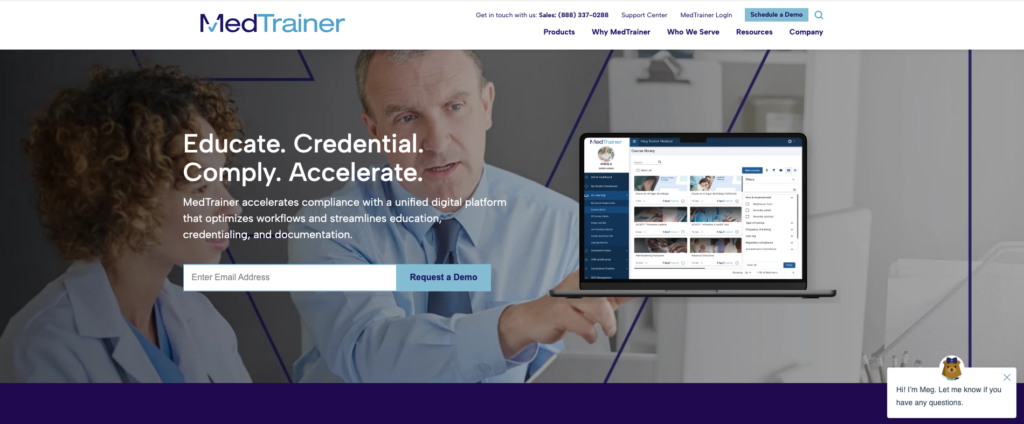
MedTrainer is a comprehensive training and credentialing platform designed for the healthcare industry.
Why I chose MedTrainer: MedTrainer offers a library of 1,000+ healthcare courses, including
compliance and continuing education units (CEU) courses, plus others that meet accreditation and regulatory institutions’ requirements.
However, some MedTrainer customer reviews mention its not-so-user-friendly interface. I find it disappointing that you can’t drag and drop multimedia content to customize courses.
Here are MedTrainer’s main features.
Ready-made course library
Admins and learners can browse MedTrainer ready-made courses using filters such as regulatory or accreditation compliance, state-specific licensing, type of healthcare industry, or user-specific tags (for instance, role specialization). I find these really useful.
MedTrainer’s library includes courses on medical ethics, molecular biology, medication management, and more. Premium courses like first aid and CPR cost extra.
Course creator
You can create training from scratch. However, I didn’t find MedTrainer’s interface very intuitive. For instance, creating a new course requires filling in a long form, and some form labels aren’t informative enough (e.g., “Approvals” or “Handouts”).
Automated tasks and reminders
MedTrainer automates repetitive admin tasks, including certificate generation and employee training reminders. Additionally, you can automatically assign courses to employees based on characteristics like job title, department, and tenure.
What users say about MedTrainer
They have such a wonderful catalog of videos and, as the administrator, it is easy to use.
The incident reporting system is easy to use, but with some quirks. The setup for it, is complicated and didn’t perform as we had expected.
Key Features
- Healthcare-specific course collection
- Training builder
- Compliance tracker
- Credentialing management
Pros
- It includes state-level compliance tools
- You pay only for the tools you use
Cons
- The interface could be more intuitive
- Lessons aren’t gamified or interactive
Pricing
Contact vendor for price Trial: No Free Plan: No
Compare the Best Healthcare Learning Management Systems
| Topic |
 Start for free
Start for free
|

|
|
|
|
|---|---|---|---|---|---|
| Reviews |
4.8
|
4.4
|
4.7
|
4.9
|
4.3
|
| Pricing |
Starts at just $29/month for the first 30 users
|
Starts at $800/month
|
Starts at $59/month
|
Contact vendor for price
|
Contact vendor for price
|
| Free Trial |
yes
14-day
|
yes
|
no
|
yes
|
no
|
| Free Plan |
yes
Free Up to 10 users
|
no
|
yes
|
no
|
no
|
| Use cases |
Best all-in-one healthcare learning management system
|
Good for: AI-powered course creation
|
Good for: Live training sessions
|
Good for: Learner collaboration
|
Good for: Ready-made healthcare-specific courses
|
| Available on |
Web, iOS, Android
|
Web, iOS, Android, Windows, Mac
|
What Is a Healthcare Learning Management System?
Healthcare learning management systems allow organizations to prepare, deliver, and assess training for their staff. LMS platforms include pre-made training programs, a course builder that lets managers import and create content, and employee learning tools—including quizzes, leaderboards, and discussion boards.
How Do Healthcare Learning Management Systems Work?
Training managers sign into the healthcare LMS with admin permissions and access a ready-built course library. They can also develop new learning content by uploading files—such as PDFs and videos—and importing courses from other LMS providers.
They can organize multimedia content with intuitive tools like drag-and-drop builders. Some platforms let admins add quizzes, which test employee knowledge with multiple-choice and other question types.
Admins then assign courses to employees automatically or manually. For instance, they may automate induction training for all new staff.
Healthcare employees get unique LMS sign-in credentials through email or SMS. They receive in-app notifications when they’re assigned new training courses, plus in-app or email reminders when completion deadlines are nearing.
Good LMS platforms optimize lessons for mobile devices so deskless healthcare workers can complete lessons on the go.
The Benefits of Healthcare Learning Management Systems
Here are the top benefits of using an LMS for healthcare.
Greater productivity
A healthcare LMS helps raise team productivity. Tools such as training completion reminders and admin progress tracking ensure employees complete courses on time—so no shift is lost due to under-training. Also, effective training on key topics like communication and diagnostics helps staff perform their duties more efficiently.
Time and cost savings
Compared with traditional in-person training, training software is relatively inexpensive. You save costs like instructor and venue fees when you distribute digital courses. You also save significant time and effort by letting employees take bite-sized lessons from anywhere, at their own pace.
Standardized training content
An LMS enables you to standardize training content, ensuring consistency across employees’ understanding of key concepts and policies. This increases the quality of patient care and reduces non-compliance risks.
By comparison, traditional live sessions are prone to subtle content variations and human error—for instance, instructors could forget crucial details. In addition, you can easily distribute standardized content across departments, facilities, and geographical locations without modifying the content.
Enhanced patient outcomes
A healthcare learning management system lets you offer a diverse mix of training—including communication skills, diagnosis protocols, hygiene checklists, and CPR—to the employees who need it. In turn, well-trained employees can solve patient problems with increased quality and speed. For instance, employees who can use hospital medical equipment efficiently can help lower patient waiting times.
Lower employee turnover
Ninety-four percent of employees would stay with an employer longer if they received learning opportunities, and almost 80% of learners value personalized courses. So, using an LMS that lets you offer personalized learning paths at scale for your entire workforce can help retain employees for longer—and save significant recruitment costs.
Better compliance
Learning platforms also help you meet compliance requirements. First, you can offer compliance training to employees—such as HIPAA standards. In addition, you get detailed records on other state-mandated training, such as patient confidentiality, health and safety, and workplace harassment.
How Much Does a Healthcare Learning Management System Cost?
Some providers prepare custom quotes according to feature requirements and number of learners. MedTrainer, for example, charges custom prices, and customers can mix and match learning, compliance, and credentialing features. Custom prices are often charged as monthly or annual subscriptions.
Platforms like TalentLMS offer tiered plans with flat monthly fees, covering a set number of users. Some, like Connecteam, offer lower flat monthly rates plus a per-user fee.
I’m confident the Connecteam LMS is one of the most affordable options. Compared to TalentLMS (starting at $69/month for up to 40 users), Connecteam starts at just $29/month for up to 30 users, plus $0.50 for each additional learner (totaling $34/month for 40 users).
That’s a bargain, considering Connecteam also packs in scheduling, time and task tracking, and much more. Plus, small healthcare organizations can use Connecteam’s 100% free plan for up to 10 users.
FAQs
A learning management system (LMS) and a content management system (CMS) address different organizational needs. Companies use LMS platforms to create, organize, and deliver employee training courses. Meanwhile, a CMS lets users store, manage, and publish content—primarily web content like web copy, images, and blog posts.
An example of a powerful learning management system (LMS) is Connecteam. You can use its pre-made courses or customize your own using existing training materials, quizzes, and bite-sized content.
Yes, HealthStream is a learning management system (LMS) for healthcare providers. It offers healthcare-specific courses, training video production services, medical product training, and more.
However, Connecteam is a better option for healthcare companies wanting to organize and distribute existing training materials in a few clicks. As a plus, it offers additional team management features for a low monthly price.
The Bottom Line on Healthcare Learning Management Systems
Traditional in-person training can be costly and error-prone while draining valuable healthcare staff time. In contrast, a healthcare learning management system lets you create and distribute cost-effective, bite-sized training content to your workforce. As a plus, tracking and reporting capabilities help keep you compliant.
Connecteam is my top all-in-one healthcare LMS choice. Its intuitive training builder helps you quickly turn existing materials into engaging courses, while progress dashboards and automated reminders help keep your team both competent and compliant.
Alongside training, Connecteam also offers HIPAA-compliant messaging, scheduling, onboarding, and so much more.


